
Lolium perenne, common name perennial ryegrass, English ryegrass, winter ryegrass, or ray grass, is a grass from the family Poaceae. It is native to Europe, Asia and northern Africa, but is widely cultivated and naturalised around the world.

Distichlis spicata is a species of grass known by several common names, including seashore saltgrass, inland saltgrass, and desert saltgrass. This grass is native to the Americas, where it is widespread. It can be found on other continents as well, where it is naturalized. It is extremely salt tolerant.

Poa nemoralis, the wood bluegrass, is a perennial plant in the family Poaceae. The late-growing grass is fairly nutritious for livestock, which feed on it in the autumn, and it is used as a lawn grass for shady situations.

Poa palustris is a species of grass native to Asia, Europe and Northern America. This plant is used as fodder and forage, and it also used for erosion control or revegetation.

Agrostis densiflora is a species of grass known by the common name California bent grass. It is endemic to the coast of northern and central California, United States, where it grows in habitat along the immediate coastline, such as dunes and bluffs.

Melinis repens is a species of grass known by the common names rose Natal grass, Natal red top, or simply Natal grass. It is native to southern Africa and an introduced species, often considered a noxious weed, on other continents such as North America and Australia. It is an annual or perennial grass, growing up to a meter tall. Its growth rate is dependent on temperature. The inflorescence is an open array of branches bearing spikelets densely coated in silky white or pink hairs.

Poa atropurpurea is a rare species of grass known by the common name San Bernardino bluegrass. It is endemic to southern California, where it is known from two regions, the San Bernardino Mountains near Big Bear and the Laguna Mountains of San Diego County.
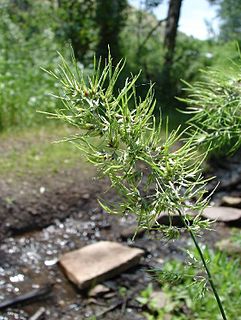
Poa bulbosa is a species of grass known by the common names bulbous bluegrass or bulbous meadow-grass. It is native to Eurasia and North Africa, but it is present practically worldwide as an introduced species. It is widespread in the United States and southern Canada. It was introduced to the eastern United States around 1906 and the western US in 1915 as a contaminant in shipments of alfalfa seed. It was intentionally planted on both the east and west coasts to control weeds and prevent erosion. Today it is a common grass across the continent and is a noxious weed in some areas. It is a sturdy, hardy, persistent, aggressive grass that easily outcompetes many other plants and becomes the dominant species in disturbed habitat types, such as overgrazed fields.
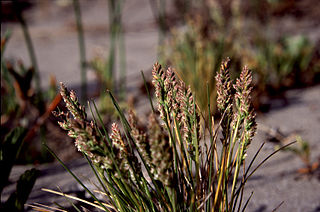
Poa confinis is a species of grass known by the common names coastline bluegrass and beach bluegrass. It is native to the coastline of western North America from British Columbia to northern California, where it grows on beaches, dunes, and other coastal habitat.

Poa cusickii is a species of grass known by the common name Cusick's bluegrass. It is native to western North America from Yukon to Colorado to eastern California, where it grows in many types of habitat, including high mountain meadows and slopes, sagebrush scrub, and forests.

Poa douglasii is a species of grass known by the common names Douglas' bluegrass and sand dune bluegrass. It is endemic to the coastline of California, where it grows in shifting sand dunes. It can be found mostly along the Central Coast and Channel Islands, and occasionally on the North Coast north of Mendocino. It is a perennial grass growing small, dense clumps up to about 30 centimeters in maximum height. It grows from a network of long rhizomes and stolons that anchor the grass to its loose sandy substrate; this network may be up to one meter long. The inflorescence is a dense, oval-shaped series of overlapping spikelets. The grass is dioecious, with male and female individuals producing different types of flowers in their inflorescences. This species, like many sand-dune endemic plants, is threatened by invasive species.

Poa glauca is a species of grass known by the common names glaucous bluegrass, glaucous meadow-grass and white bluegrass. It has a circumboreal distribution, occurring throughout the northern regions of the Northern Hemisphere. It is also known from Patagonia. It is a common grass, occurring in Arctic and alpine climates and other areas. It can be found throughout the Canadian Arctic Archipelago in many types of habitat, including disturbed and barren areas.

Poa howellii is a species of grass known by the common name Howell's bluegrass.
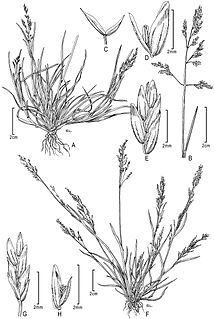
Poa infirma is a species of grass known by the common names early meadow-grass and weak bluegrass. It was first described from a specimen found in Colombia, but it is actually an introduced species in the Americas and is native to Europe. It grows in many types of habitat, including disturbed areas. It is very similar to Poa annua, which is probably a daughter species, and it is often mistaken for P. annua unless it is closely examined.

Poa kelloggii is a species of grass known by the common name Kellogg's bluegrass. It is endemic to the North and Central Coasts of California, where it grows in coastal forests, including redwood forests. It is a perennial grass producing single stems or loose clumps of several stems up to 85 centimeters tall. The inflorescence is a series of branches along the stem which spread out and then droop as the fruit matures. The flattened spikelets occur at the tips of the thin branches.

Poa leptocoma is a species of grass known by the common names marsh bluegrass and western bog bluegrass.
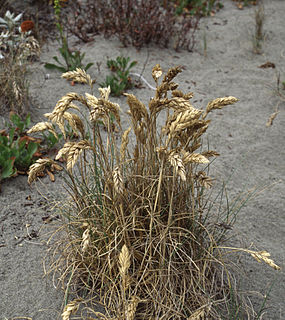
Poa macrantha is a species of grass known by the common names seashore bluegrass and large-flowered sand dune bluegrass. It is native to the west coast of North America from Alaska to northern California, where it grows in sand dunes and other beach habitat.

Poa napensis is a rare species of grass known by the common name Napa bluegrass. It is endemic to Napa County, California, where it is known from only two occurrences near Calistoga. It grows in moist, mineral-rich soil around hot springs. The rare grass only occurs on private, unprotected land and depends on water from the hot springs; changes to the local water regime or any other aspects of its specific habitat type would affect the plant. This grass was federally listed as an endangered species in 1997, along with another rare local hot spring endemic, the Calistoga popcornflower.
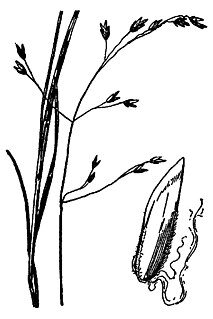
Poa paludigena is a species of grass known by the common names bog bluegrass, marsh bluegrass, slender marsh bluegrass, and Patterson's bluegrass. It is native to the northeastern United States.
Bluff Lake is a lake in the Big Bear Valley of the San Bernardino Mountains, in San Bernardino County, California. It is located southwest of Big Bear Lake reservoir and Big Bear City.



















